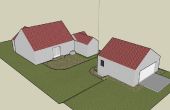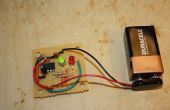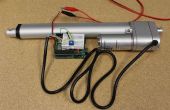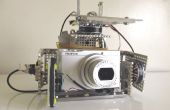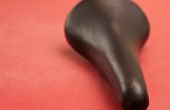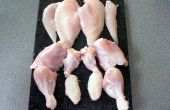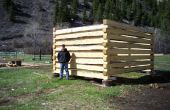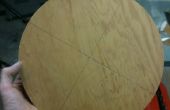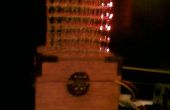Stap 5: Volg dat bureaulamp!
OK, dus misschien is er een betere toepassing dan het bijhouden van een bureaulamp... :)
Als u uploadt de code dat volgt op de Arduino, u moet kunnen reproduceren de resultaten in de video.
/* This script moves an actuator until maximum analog input is acheived. While it's example application is to track a light source with a solar cell that is attached to the end of the actuator, it could be used to track maximum input of anything attached to the LIGHT_SENSOR_PIN. maybe like sound source tracking too? :) */ #define ACTUATOR_AMP_SENSOR_PIN A5 #define ACTUATOR_PWM_PIN 11 #define ACTUATOR_DIR_PIN 12 #define LIGHT_SENSOR_PIN A4 // MAX speed is 255 - this is the value that gets written // to the ACTUATOR_PWM_PIN. Note do not change or limit // detection will no work #define ACTUATOR_SPEED 255 // when the amp sensor analog value is between these, it is // considered to be at rest (no current being drawn). #define ZEROAMP_RANGE_LOW 505 #define ZEROAMP_RANGE_HIGH 520 // directions for the actuator (value gets set to ACTUATOR_DIR_PIN) #define RETRACT 0 #define EXTEND 1 // don't move if sampled light input value is within // STILL_TOLERANCE of g_lastInputValue #define STILL_TOLERANCE 2 // move actuator until drop from max is less than #define SEEK_TOLERANCE 2 // minimum number of milliseconds delay between sampling the ACS712 // recommended in manufacturer sample source #define SAMPLING_DELAY 1 int g_currentDirection = EXTEND; int g_lastInputValue = 0; // limited to 255 char strings void serialPrintf(char const *format, ...) { char buffer[255]; va_list args; va_start(args, format); vsprintf(buffer, format, args); va_end(args); Serial.println(buffer); } boolean isActuatorMoving() { int val = analogRead(ACTUATOR_AMP_SENSOR_PIN); // serialPrintf("Amp sensor reading: %d", val); return val < ZEROAMP_RANGE_LOW || val > ZEROAMP_RANGE_HIGH; } void stopActuator() { analogWrite(ACTUATOR_PWM_PIN, 0); } boolean almostEqual(int a, int b, int tolerance) { return a >= b - tolerance && a <= b + tolerance; } // mSeconds = optionally move in direction for n milliseconds and then stop // returns false if mSeconds != 0 and at end of travel boolean moveActuator(int direction, int mSeconds=0) { serialPrintf("moving actuator direction=%d", direction); analogWrite(ACTUATOR_PWM_PIN, ACTUATOR_SPEED); digitalWrite(ACTUATOR_DIR_PIN, direction); if(mSeconds > 0){ delay(mSeconds); boolean stillMoving = isActuatorMoving(); stopActuator(); return stillMoving; } return true; } // returns the number of milliseconds taken unsigned long moveActuatorToEnd(int direction) { long startMs = millis(); moveActuator(direction); while (isActuatorMoving()){ delay(SAMPLING_DELAY); // slight delay between sampling the ACS712 module is recommended } stopActuator(); long endMs = millis(); return endMs - startMs; } void changeDirection(int direction = -1) { if (direction == -1) direction = g_currentDirection + 1; // mask to single bit - 0 or 1, so 0 + 1 becomes 1 and 1 + 1 becomes 0 g_currentDirection = direction & 1; } // finds the max input by moving through the full range of motion void calibrate() { moveActuatorToEnd(EXTEND); // start fully extended long tMaxInput = 0; // time elapsed while retracting that max input was achieved int maxInput = 0; // what was the input long startMs = millis(); moveActuator(RETRACT); while (isActuatorMoving()) { int inputValue = analogRead(LIGHT_SENSOR_PIN); if (inputValue > maxInput) { maxInput = inputValue; tMaxInput = millis() - startMs; delay(SAMPLING_DELAY); } } long endMs = millis(); // move back to point in time when at max moveActuator(EXTEND, endMs - startMs - tMaxInput); } // returns false if at end of travel boolean seekHighInput(int pin, int direction, int inputValue) { int nextInputValue = inputValue; int maxInputValue = inputValue; boolean stillMoving; boolean atMax; serialPrintf("seeking to high input in direction %d. inputValue=%d", direction, inputValue); moveActuator(direction); do { delay(SAMPLING_DELAY); stillMoving = isActuatorMoving(); if (nextInputValue > maxInputValue) maxInputValue = nextInputValue; nextInputValue = analogRead(pin); serialPrintf("stillMoving=%d nextInputValue=%d", stillMoving, nextInputValue); atMax = almostEqual(nextInputValue, maxInputValue, SEEK_TOLERANCE); } while (stillMoving && atMax); stopActuator(); return stillMoving; } void seekToLight() { boolean stillMovable; int inputValue = analogRead(LIGHT_SENSOR_PIN); int initialValue = inputValue; if (almostEqual(inputValue, g_lastInputValue, STILL_TOLERANCE)) { return; } stillMovable = seekHighInput(LIGHT_SENSOR_PIN, g_currentDirection, inputValue); inputValue = analogRead(LIGHT_SENSOR_PIN); boolean lessThanAtStart = inputValue < initialValue - STILL_TOLERANCE; if (!stillMovable || lessThanAtStart ) { changeDirection(); } // if we are receiving less input than at start of this call, changeDirection // and go back to max if (lessThanAtStart) { seekHighInput(LIGHT_SENSOR_PIN, g_currentDirection, inputValue); } g_lastInputValue = inputValue; } // the setup routine runs once when you press reset: void setup() { // initialize serial communication at 9600 bits per second: Serial.begin(9600); pinMode(ACTUATOR_PWM_PIN, OUTPUT); pinMode(ACTUATOR_DIR_PIN, OUTPUT); pinMode(ACTUATOR_AMP_SENSOR_PIN, INPUT); pinMode(LIGHT_SENSOR_PIN, INPUT); // we really don't need to calibrate anything, the seek algorithm should handle // variance in the ranges of inputs to the light sensor. // // the scan of the range of movement for highest input source that calibrate() // performs may come in handy in high ambient light environments where it's hard // to distinguish a singular source. The seek algorithm may need to be iterated // on to better support high ambient light environments // //calibrate(); serialPrintf("setup complete"); } // the loop routine runs over and over again forever: void loop() { seekToLight(); }
